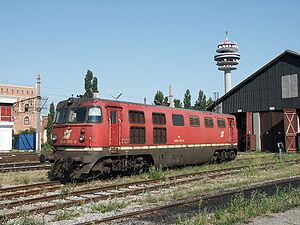ÖBB 2050
| ÖBB 2050 | |
|---|---|
|
2050 017-9 towards the end of her career at the Vienna Ostbahnhof
|
|
| Numbering: | 2050.01-18 |
| Number: | 18th |
| Manufacturer: |
Henschel
(under license from GM ) |
| Year of construction (s): | 1958–1962 |
| Retirement: | 2004 |
| Axis formula : | Bo'Bo ' |
| Length over buffers: | 17,740 mm |
| Service mass: | 75.5 t |
| Top speed: | 100 km / h |
| Continuous output : | 1,119 kW (1,450 hp) |
| Starting tractive effort: | 178 kN |
| Number of traction motors: | 4th |
| Drive: | diesel-electric |
| Train control : | Sifa Indusi tw. |
The series 2050 was a diesel locomotive of the ÖBB . It was one of the series whose drive know-how was imported from the USA . The procurement of the locomotives goes back to the demonstration services of the General Motors (GM) Group, the series was in use at the ÖBB until 2004.
history

The procurement of the 2050 series goes back to the first Austrian post-war design ( ÖBB 2045 series ), of which a total of 20 locomotives were built by the local industry between 1952 and 1955 - these had American trains in terms of design. In the summer of 1955, General Motors and its German partner Henschel presented a European model locomotive of the "Road-Switcher" type (a shunting locomotive suitable for use on the route). This was the G12 7707 locomotive, which was used in demonstrations on Semmering and on the southern runway. These positive results prompted the ÖBB to purchase a first series of ten locomotives in 1958 and a further eight in 1962 - these were classified as 2050.001 to 018. The locomotives were manufactured at Henschel under license from General Motors, the bogies were manufactured and supplied by Austrian industry ( SGP plant Vienna Floridsdorf ).
The series proved itself very well due to its performance and the robust diesel-electric drive, but was not yet able to replace the steam locomotive in the non-electrified network of the ÖBB due to its small number . It was mainly used in freight traffic, but was also found in passenger train traffic for a few years.
Up to May 1, 2004, eight locomotives were formally in the ÖBB fleet, which were assigned to the Vienna East traction location. They had all been turned off, however, and the payment was made in the course of 2004. 2050.02 was assigned to the ÖBB nostalgia inventory. 2050.04 went to the Sigmundsherberg Railway Museum on December 1, 2003 and was sold to the Strasshof Railway Museum in 2011 together with the 2050.02. The locomotive 2050.09 was restored to the condition of the 1970s with a decorative pointed tip and impeller and was acquired in 2015 by the Neue Landesbahn association, which is based in Mistelbach. This is also available as a museum locomotive. Several other copies were acquired by the Austrian Society for Railway History and, except for the 2050 05 (original paintwork in green), were initially stored in the railway museum in Ampflwang in a non-operational condition .
construction
The series 2050 was procured in box design with two end driver's cabs and an engine compartment in between - the demonstration locomotives, following American design principles, had a middle driver's cab. The box rests on a welded bridge girder (in box design), which is connected to the side walls and parts of the roof and thus forms a load-bearing structure. The side walls are perforated with fan grilles. The box rests - by means of flexicoil springs - on two bogies, which were manufactured by the manufacturer SGP in a fully welded box construction with an outer frame. The paintwork of the locomotives that still exist today is different: 2050.02 and 04 have the original green paint, one part is still blood orange and another part is painted traffic red with a belly band.
technology
The 2050 series is a diesel-electric locomotive. The twelve-cylinder two-stroke V-diesel engine of the GM-Electro-Motive Division from La Grange, Illinois USA with a displacement of 112 l works according to the so-called direct current flushing process . A generator system is coupled to the motor , which supplies direct current for the four parallel-connected tatzlager drive motors , which drive the wheel sets via a gear train. The engine output can be changed in eight stages by adjusting the speed. All locomotives have an automatic braking system, an indirect air pressure brake and Sifa - Indusi is only partially available. 2050.02 was the only one to have a train heating system (visible on the roof superstructure) after an interim expansion, in order to be available for express and special trains. 2050.012 and 016 - 018 are tandem capable, i.e. they can be operated in double traction from a driver's cab by just one engine driver.
literature
- Markus Inderst : Picture atlas of the ÖBB locomotives. All traction vehicles of the Austrian Federal Railways. GeraMond, Munich 2010, ISBN 978-3-7654-7084-4 .
- Erich Doleschal, Heinz Gerl, Helmut Petrovitsch, Wilhelm Saliger: Traction vehicles of Austrian railways - diesel locomotives and diesel multiple units , alba-Verlag, Düsseldorf, 1993, ISBN 3-87094-150-2
- Bahn im Film Video production: ÖBB 2050 . DVD 65 min., Achau 2000-2006.

